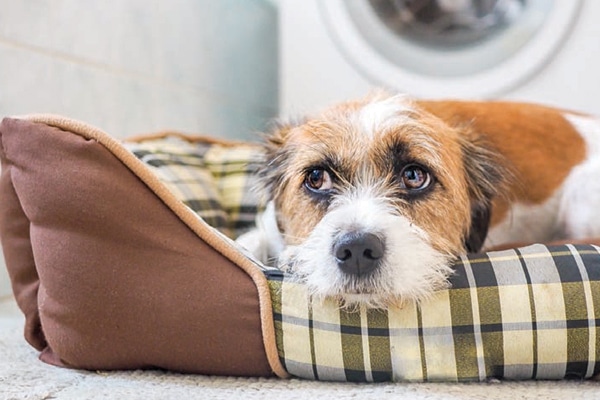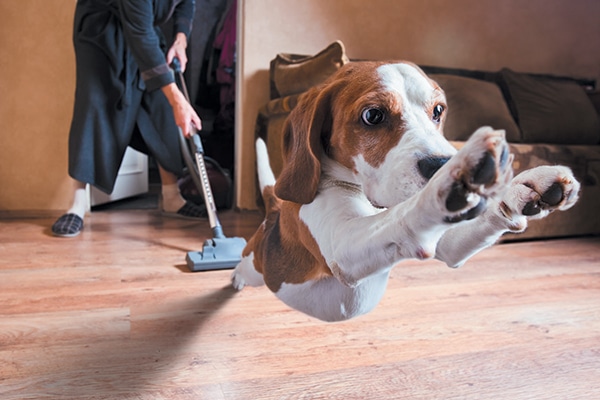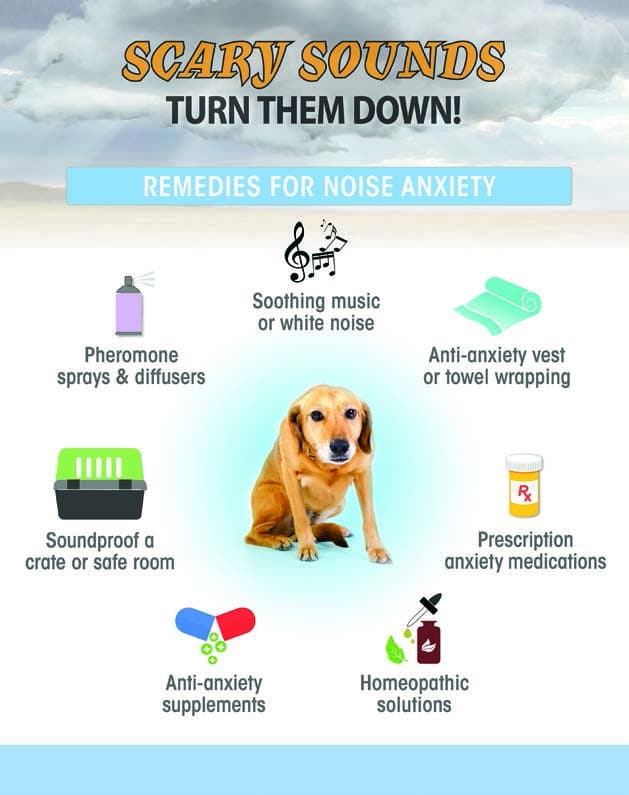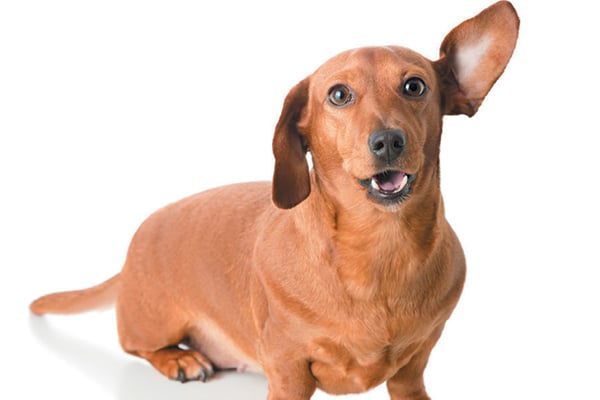The post Sounds That Scare Dogs — And What to Do About Them by Arden Moore appeared first on Dogster. Copying over entire articles infringes on copyright laws. You may not be aware of it, but all of these articles were assigned, contracted and paid for, so they aren’t considered public domain. However, we appreciate that you like the article and would love it if you continued sharing just the first paragraph of an article, then linking out to the rest of the piece on Dogster.com.
Dogs don’t need to see something scary to turn into puddles of panic. There are tons of sounds that scare dogs, unfortunately. Certain sounds that scare dogs can cause them to pace, drool, shake, shadow you or desperately seek a safe refuge like inside the bathtub.
Some dogs with noise phobias can become petrified with fear even before the dreaded sound arrives, because they pick up on pre-sound warning cues.
“My dog, Rusty, is terrified of the smoke detector in our kitchen,” says Nicholas Dodman, BVMS, professor emeritus at Tufts University’s School of Veterinary Medicine, a board-certified veterinary behaviorist and lead veterinarian at the Center for Canine Behavior Studies in Salisbury, Connecticut. “He has learned that turning on our indoor grill may cause the smoke alarm to go off, so he starts to shake and tremble with fear when he sees us bring out the indoor grill. So, I distract him in another room while my wife, Linda, works the indoor grill. Rusty has learned what we call a behavioral chain, a common occurrence in dogs with noise phobias.”
What are some common sounds that scare dogs?

What sounds scare dogs? Photography ©Sonja Rachbauer| Getty Images
By definition, veterinarians and animal behaviorists use the term “noise phobia” to describe the intense and irrational fear displayed by some dogs to certain sounds. It is important to make the distinction that fear is a normal emotional response to a real or perceived threat or situation, such as dreading the anticipated pain from a vaccination needle. However, fear can escalate to a phobia, an exaggerated and irrational response that can completely emotionally cripple a dog.
Topping the list of sounds that scare dogs:
- thunderstorms
- fireworks
- loud trucks
- gunshots
- people yelling
- squawking pet parrots
- security alarms
- smoke detectors
But your dog may develop a noise phobia to more unusual sounds based on past experience, such as the wheels of a skateboard, the buzzer on a game show on TV or the popping of bubble wrap used to pad packages.
Sounds that scare dogs are a pretty common problem

Sounds that scare dogs aren’t uncommon, unfortunately. Photography ©igorr1 | Getty Images.
Sounds that scare dogs and escalate into noise phobia in dogs are more common than you may realize. Dr. Dodman estimates that close to 50 percent of dogs have some signs of fear and anxiety to sounds, sights and situations. But there is no study known that breaks down the percentage of dogs with fears or phobias to perceived scary sounds.
“Fear and anxiety rank as the No. 1 issue with dogs,” says Dr. Dodman, who ran the Animal Behavior Clinic at Tufts for more than two decades and is a best-selling pet author. “No one knows for sure, but it may have to do with their physical size, shape, structure, their temperaments and/or environmental influences.”
Most of Dr. Dodman’s canine clients being treated for thunderstorm phobia tended to be large and hairy. He has treated more breeds like German Shepherd Dogs, Labrador Retrievers, Golden Retrievers and Bernese Mountain Dogs for noise phobias than he has for breeds like Greyhounds, Shih Tzus or Dachshunds.
“A dog’s coat is a perfect receptacle for an electric charge, especially dogs with long-haired coats,” he notes. “Things and animals can get statically charged in a storm.”
Signs of fear

Is your dog hiding? He might have a noise phobia. Photography ©Alexandr Zhenzhirov | Getty Images
How a dog reacts to a fearful sound also depends on whether or not his best friend – you — are in the room or the dog is home alone.
“Clinical signs can differ, but if you are with the dog when the noise occurs, the typical behavior is for the dog to go into Velcro mode and be close to you, even press into you as the dog shakes and trembles with fear,” Dr. Dodman says. “But if you are not present to provide solace to the dog, separation anxiety is also usually present. These dogs are in extreme anxious states and tend to vocalize, have accidents on the floor and desperately try to hide or escape what they regard to be a house of horrors.”
Other signs of sounds that scare dogs can include: inappropriate chewing (your shoes, the television remote, etc.), drooling, excessive barking, diarrhea and vomiting, digging (including the living room rug), panting heavily, pacing and displaying “whale eye” — a panicky look in which you can see the whites of the eyes.
Tools to calm a noise phobia

While there is no one cure or one-size-fits-all solution to minimize sounds that scare dogs has or even make them disappear altogether, you do have plenty of tools at your disposal.
- For starters, strive to be calm around your dog and avoid baby talk or panicky tones. Dogs are masters at reading our emotional states. And, consult a professional dog behaviorist or dog trainer to help modify your dog’s behavior. Keep in mind that behavior modification techniques build on small but steady successes, and you need to be patient. Never yell at your dog for his fear-related destructive behavior, as your dog could start to associate the loud noises with a punishment, too.
- As for products, work with your veterinarian to see if these may aid the reaction in your dog: Anti-anxiety vests, ThunderShirts, anti-static jackets or even towel wrapping your dog to help him feel less anxious or frightened. If your dog is afraid of storms, you can try rubbing his coat with antistatic laundry dryer sheets.
- Pheromone sprays and diffusers. These commercial products emit dog-appeasing pheromones that help some dogs calm down in stressful or scary situations.
- Soothing music or white noise to help block out the source of the fear-causing sound.
- Soundproof a crate or safe room for your dog to go to before a storm strikes.
- Some dogs require supplements or prescription medication to help them cope with noise phobias, especially to thunderstorms. The popular go-to medications prescribed by veterinarians include clonidine, clomipramine, fluoxetine, benzodiazepine and Prozac. Keep in mind that your veterinarian may recommend a combination of these drugs or may prescribe for use before a storm arrives to minimize your dog’s response. Go to a holistic veterinarian if you prefer more homeopathic solutions like herbs, essential oils, Bach flower remedies or Traditional Chinese Medicine (TCM).
- Dr. Dodman shares one final key bit of advice: Don’t wait to get your pup or young dog treated for a noise phobia. “If your 10-month-old dog is starting to show signs of fear to a sound like thunder, don’t dismiss it and think you can just live with his pacing, because trust me, it will get worse if unchecked. I guarantee that. Get help sooner than later.”
When it comes to hearing, dog ears rule

Dogs have much better hearing than humans. Photography ©Azret Ayubov | Getty .
When it comes to a hearing contest, dogs have us beat, paws down. On average, there are about 12 muscles per canine ear that can be tilted, turned, raised and lowered to zero in on sounds at greater distances and wider frequencies than human ears.
Dogs can hear sounds within 67 to 45,000 hertz range as compared to people who can hear sounds within a range of 63 to 23,000. Hertz (Hz) is a measure of sound frequency or cycles per second.
That explains why your dog can be snoozing in an upstairs bedroom but hear you open a bag of potato chips in the kitchen and come bounding your way.
Thumbnail: © mattjeacock |Getty Images & © GlobalP | Getty Images.
About the author
Arden Moore, the Pet Health and Safety Coach, is a pet behavior consultant, master certified pet first-aid instructor, author and host of the Oh, Behave Show on Pet Life Radio. Learn more at ardenmoore.com.
Editor’s note: This article appeared in Dogster magazine. Have you seen the new Dogster print magazine in stores? Or in the waiting room of your vet’s office? Subscribe now to get Dogster magazine delivered straight to you!
Read more related articles on Dogster.com:
The post Sounds That Scare Dogs — And What to Do About Them by Arden Moore appeared first on Dogster. Copying over entire articles infringes on copyright laws. You may not be aware of it, but all of these articles were assigned, contracted and paid for, so they aren’t considered public domain. However, we appreciate that you like the article and would love it if you continued sharing just the first paragraph of an article, then linking out to the rest of the piece on Dogster.com.
No comments:
Post a Comment